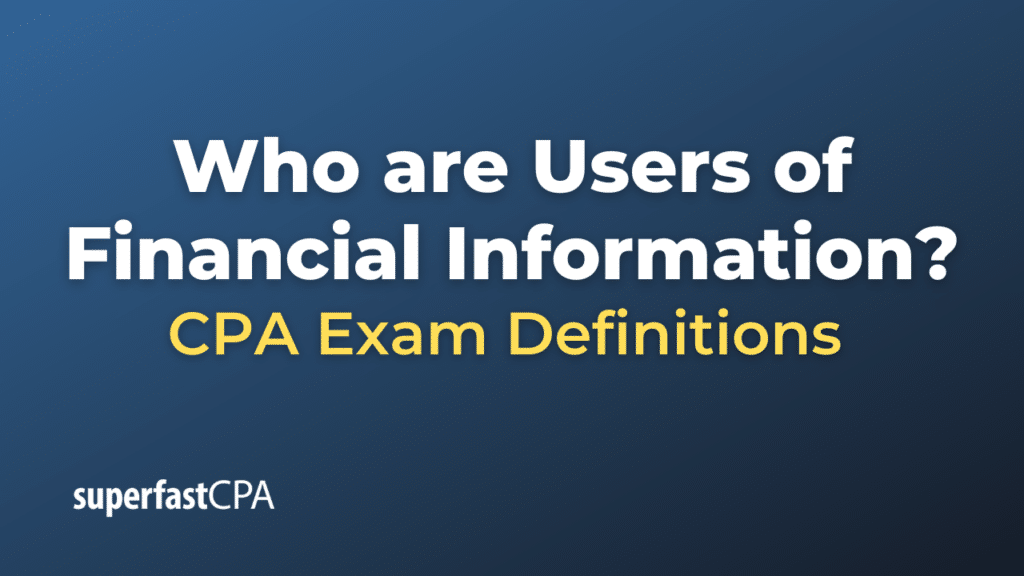Users of Financial Information
Users of financial information are the various individuals, groups, or organizations that rely on financial data to make decisions. These users can be classified into two broad categories: internal users and external users.
Internal Users
- Management: Executives and managers use financial information to make strategic decisions, allocate resources, and manage operations effectively.
- Employees: Employees may use financial information to understand the company’s performance and prospects, which can affect job security and opportunities for advancement.
- Owners/Shareholders: They need financial data to assess the performance and value of their investment and to make decisions on their continued investment or disinvestment.
- Investors: Prospective and current investors use financial information to assess the viability and profitability of investing in a company’s stocks or bonds.
- Creditors: Banks, suppliers, and other lenders look at a company’s financial information to evaluate the risk associated with lending money or extending credit terms.
- Regulators: Government agencies review financial statements to ensure that the company is in compliance with laws and regulations.
- Analysts: Financial analysts use company data to make recommendations on buying, holding, or selling investments.
- Customers: Though they are not typically thought of as traditional users of financial information, some customers may examine a company’s financial health to determine its ability to continue providing goods or services in the long term.
- Competitors: Competitors may analyze financial information to compare their performance and strategy with those of others in the industry.
- Tax Authorities: Tax agencies use financial statements to verify the accuracy of taxes paid by the company.
- Media and Public: Journalists and the general public may use financial information to assess the performance and social responsibility of a company.
Information Needs
Different users have different information needs:
- Management may need detailed financial data on a weekly or even daily basis, with a focus on specific departments or projects.
- External users like investors and creditors are often more interested in summary data provided through quarterly or annual reports.
Financial information typically comes from accounting records and is presented in the form of financial statements, including the income statement, balance sheet, and cash flow statement. Supplemental notes and management’s discussion and analysis (MD&A) also provide valuable insights. The quality, credibility, and reliability of financial information depend on accounting standards like the Generally Accepted Accounting Principles (GAAP) or International Financial Reporting Standards (IFRS) and are often verified by external audits.
Understanding the needs of the different users of financial information is crucial for companies in presenting their financial data and for users themselves to make well-informed decisions.
Example of Users of Financial Information
Let’s consider a hypothetical example featuring a small business called “HealthyBites,” which specializes in organic snacks. Here’s how various users might interact with the company’s financial information:
Internal Users:
- Management: The CEO and other executives would look at the income statement, balance sheet, and cash flow statement to evaluate profitability, manage cash flows, and make decisions about future investments or cost-cutting. They might also assess segment reports that break down revenues and costs by product line or geographical area.
- Employees: Staff might be interested in financial stability and profit-sharing options. A strong financial performance could mean job security and potential bonuses.
- Owners/Shareholders: As a small business, the owners or shareholders would be keenly interested in all financial metrics, particularly profitability and return on investment, to decide whether to reinvest profits or distribute them.
External Users:
- Investors: Although HealthyBites is a small company, it may have external investors or might be considering an initial public offering (IPO). Potential investors would scrutinize financial statements to assess risks and project future earnings.
- Creditors: A bank considering lending money to HealthyBites would look at liquidity ratios, like the current ratio, and solvency metrics, like the debt-to-equity ratio, to evaluate the company’s ability to repay loans.
- Regulators: Government agencies would require HealthyBites to file tax returns and might review financial statements to ensure compliance with tax laws and other regulations, such as food safety standards.
- Suppliers: Suppliers of organic ingredients might look at HealthyBites’ financial health to assess its ability to pay for goods on time.
- Customers: Larger clients, like retail chains, might review HealthyBites’ financials to ensure the company has the operational capacity and financial stability to fulfill large, recurring orders.
- Competitors: Rivals might look at HealthyBites’ revenue growth and market share as published in industry reports, to assess how it is impacting their competitive position.
- Tax Authorities: The IRS or equivalent would be interested in HealthyBites’ revenue numbers and deductions to ensure they are paying the correct amount of tax.
- Media and Public: If HealthyBites gains attention for its rapid growth or unique business model, journalists might look at its financial statements to write reports or articles. The public might be interested if HealthyBites is a prominent local employer or if its products affect public health and wellbeing.
Each of these users will have unique concerns and will focus on different aspects of HealthyBites’ financial information. By understanding these varied needs, HealthyBites can better present its financial data and engage effectively with each type of user.












